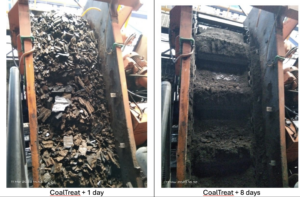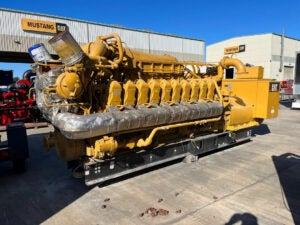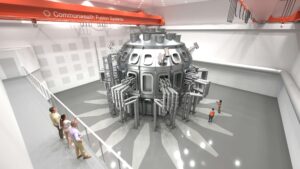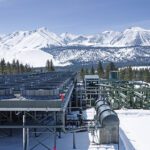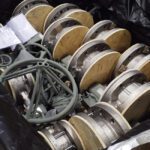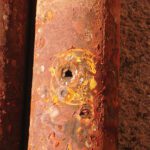Turbines play an integral role in power production, turning steam into mechanical energy that generates electricity. Though large and powerful, these dynamic pieces of equipment are also vulnerable and must be kept in pristine condition for efficient service and longevity.
 |
|
1. These images show flash rust on a turbine after initial cleaning attempts, before the use of a stronger rust removal agent. Courtesy: Cortec |
Unfortunately, some power plant environments set turbines up for failure. Warm, humid sea air leaves behind salt deposits or flash rust (Figure 1) on turbines at coastal power plants. Harsh steam carrying hydrogen sulfide, or H 2 S, and minerals from the ground wreaks havoc on equipment at geothermal plants.
When working with turbines in these environments—or really any situation where a turbine may be temporarily offline—it is important for power plant workers to have simple strategies to remove buildup, prevent flash rust, and keep idle turbines in peak operating condition to maximize efficiency and uptime.
Hang on for the Rough Ride: The Need for Deeper Cleaning
Any type of buildup on turbine blades can upset the equilibrium of the power generation process. Whether that imbalance is caused by salt, scale, or rust, it is critical to remove the buildup for efficient operation and maximum service life.
In one case, a Turkish power plant located in a coastal environment was having trouble with salt buildup on turbine blades. This threw the turbine out of balance, creating an unacceptable increase in vibration that significantly decreased efficiency and power output.
Scale can cause the same problems and is a greater concern in geothermal power plants because of the high mineral content that can accelerate scale buildup. Some geothermal systems feed steam directly from the ground into the turbine, creating a perfect recipe for scale formation that gradually increases vibration levels and decreases power output as calcium carbonate or other mineral deposits thicken on the blades.
Corrosion also reduces turbine efficiency and service life. Worse yet, corrosion products threaten to fall off and contaminate the delicate system, causing further operational problems. Once begun, corrosion spreads more easily, accelerating turbine deterioration. It is important to stop this progression early; the loss of too much metal cross section puts increased stress on the turbine (especially the turbine flow path), ultimately leading to failure and shortened service life.
In each of these cases, cleaning away unwanted buildup is integral to restoring balance and maximizing efficiency and service life. While many methods exist, biobased removers and cleaners are of special interest for maintenance managers who value sustainability.
For chloride removal, workers can turn to FlashCorr VpCI, a cleaning agent that contains 64% U.S. Department of Agriculture (USDA)–certified biobased content. This chemistry is designed to neutralize and remove salt deposits from metal surfaces, also protecting against flash rust.
EcoClean Biodegradable Scale and Rust Remover Powered by Nano-VpCI can (as its name implies) be used to remove scale. This formula contains 100% USDA-certified biobased content and is more worker-friendly compared to harsher scale remover chemicals such as muriatic acid.
For rust removal, VpCI-423 (which contains 91% USDA-certified biobased content) can be applied to corroded areas and removed with VpCI-414, an alkaline cleaning solution that neutralizes the acid and leaves behind flash corrosion inhibitors. VpCI-423 should be left on for shorter or longer periods depending on the severity of the rust. For treatment longer than 20 to 30 minutes, workers should cover VpCI-423 with plastic wrap to keep the gel from drying out.
Warding Off Rust During Maintenance
Interestingly, although scale and salt can build up during operation, most turbines do not rust while in service because of the extreme heat and velocity of the steam. (One exception is the last two rows of turbine blades in the low-pressure, or LP, turbine, especially at nuclear power plants. These last rows run very cold and are therefore at risk for condensation corrosion even during operation.) Typically, the risk of corrosion increases when turbines are shut down for maintenance or layup. Since flash rust can appear overnight, a good habit is to spray turbines with a light coating of rust preventative at the end of each day’s maintenance work.
 |
|
2. These images show turbines after being cleaned with rust removal and corrosion protection agents. In each case, the turbine was treated using VpCI-422, VpCI-414, and ElectriCorr VpCI-239. Courtesy: Cortec |
ElectriCorr VpCI-239 (Figure 2) has become a favorite for many because of its versatility. Not only does it offer a quick layer of corrosion protection, but it also doubles as a cleaner that can be used to remove light rust or grime before spraying on the final layer of protection and leaving it to dry. Once the turbine is started, the heat and moisture of the steam environment will rinse the coating away in about 30 seconds without system interference.
ElectriCorr VpCI-239 proved to be a lifesaver for the Turkish power plant mentioned above. Initially, the problem was salt buildup on the rotor, so workers took the turbine out of the casing and blasted off the salt following original equipment manufacturer (OEM) recommendations.
However, by the time they were ready to return the turbine to the casing, the turbine had rusted, requiring another cleaning. The same problem happened several times because of the high-chloride, moisture-laden environment. Neither the suggestions of the OEM nor the project’s architectural engineering group worked. They simply were not able to find a way to keep the rust off. Finally, they consulted an expert at Cortec who had seen similar problems.
Following his recommendations, they used VpCI-422 (a less-viscous version of VpCI-423) for rust removal and VpCI-414 (diluted) for rinsing, neutralization, and flash rust prevention. Once the surface was dry, they sprayed it with ElectriCorr VpCI-239. Because of the previous difficulties, the facility manager insisted workers leave the turbine on the laydown deck for a week to make sure it stayed rust-free. Only then did they install it, finally satisfied with a solution that met their needs.
Keeping Turbines Pristine During Layup
In addition to protection during short-term maintenance, turbines need long-term preservation during extended layup. This applies both to the routine ongoing layup of critical spares, as well as the periodic layup of primary assets when the entire power plant faces a shutdown. The vulnerability of turbines to corrosion at these times makes effective rust prevention imperative, while their critical nature makes it important to choose a method that will allow for speedy de-preservation and startup to minimize downtime.
Often, a full plant shutdown lasts several years, but occasionally a plant may shut down for three to six months to replace large pieces of equipment. Workers laying up a rotor for just a few months can again turn to ElectriCorr VpCI-239 for protection of the rotor, blades, shaft, and casing applied at the time of inspection.
For longer periods, workers should fog a vapor phase corrosion inhibitor inside the turbine casing to protect the flow path. The advantage of this chemistry is vapor diffusion, allowing corrosion inhibitors to spread throughout the enclosure and form a molecular protective layer on all surfaces—not just those to which the product is directly applied.
Unlike nitrogen blanketing, which will completely fail if pressure is not maintained, vapor phase corrosion inhibitors will replenish their corrosion-inhibiting layer for ongoing protection even if the enclosure is briefly opened. If the turbine rotor is not in a casing, it can be shrouded in vapor phase corrosion inhibiting shrink film to trap the corrosion inhibiting vapors within the package.
The oil system may be protected by applying a corrosion inhibitor such as M-535, an ashless chemistry, to the lubricating oil and circulating it through the system before shutdown. M-535 contains vapor phase corrosion inhibitors, which as mentioned do not need to be applied directly to each surface to achieve protection.
Turbines are integral power plant assets that can experience setbacks from salt, scale, and corrosion buildup. Knowing when and how to clean and preserve them can play a critical role in effective maintenance and efficient operation. By removing buildup, warding off rust during maintenance, and keeping turbines in pristine condition during layup, power plants will be better equipped to stay mission-ready in even the harshest conditions.
—James (Jim) E. Holden, PE, is the engineering and technical sales director at Cortec Global Services. Julie Holmquist is a content writer at Cortec Corp.



